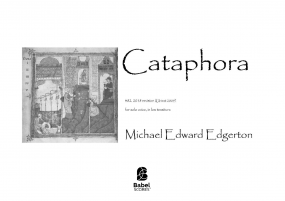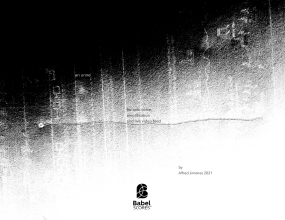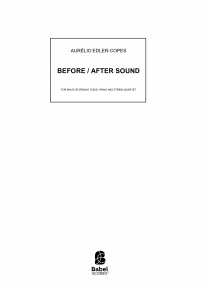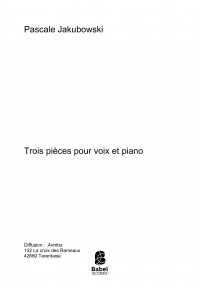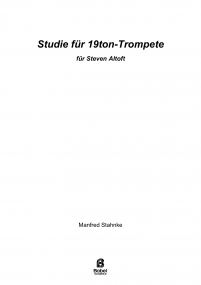Anaphora
ISMN : 979-0-2325-0961-7
- Login to create your own lists
CAT# (YEAR COMPOSED): 62 (2001)
INSTRUMENTATION: solo voice
PAGES: 13
DURATION (APPROX): 20’00
PREMIERE PERFORMANCE: Premiere during “Ursprung” (experimental music theater) in the Kleiner Wasserspeicher, Berlin Prenzlauerberg during the Festival ‘Reservoir V’, 2001
NOTE: Dedicated to and written for Rebekka Uhlig
Paul Renan Zelezniak in 2008 writes, "This unaccompanied solo utilises hitherto untapped resources of the human voice. In achieving this, the central concern in this work was, in the words of the composer,” to maintain a sense of coherence that would carry through the procedure of kaleidoscopic change”. In addition, Edgerton refers to the “convention of repetition at phrase inception” employed by Shakespeare in Richard II. This not only comprises the constant variation of a single germinal idea (in this case the gamut of emotions expressed by John of Gaunt for the England he loved) but the dramatic effect of repetition itself. Silence between the repetitions functions as the space in which the sound lives. Thus, rather than segregating the repetitions, the pauses maintain a subtle and cohesive impetus throughout. The innate pathos of the work seems to derive from the archaic symbols that embody primal emotions that are integral to the piece. A high degree of intensity is generated, often where dynamics are quieter. The listener is compelled to look inward, to respond rather than to project, and to become aware of the multiplicity of events that occur within a single sound."
WHAT OTHERS SAY ABOUT ANAPHORA
2011. Regarding the performance of Anaphora by Almut Kühne in the Leonhardi-Museum Dresden aus: “Licht-Risse” 2011.04.29 in the ProgrammeTexte by Olaf Katzer, Artistic Director, AUDITIVVOKAL DRESDEN (translated by M. Edgerton)Forty years after Luciano Berio’s “Sequenza” the American composer Michael Edward Edgerton has illuminated in his study “Anaphora” the expressive potential of the human voice. A kaleidoscope of 56 different categories of vocal multiphonics shows the wealth that the human carries in vocal expression. It pays to listen closely because simply there are many never heard before sound landscapes, in which multiphonic and polyphonic sound cosmos appears, although they are given by only one woman. These sounds are based neither on witchcraft, nor cast by a mystical spell, but are the result of scientifically based research in the field of voice, made by the composer himself and in his book “The 21st Century Voice”.
Since the publication of his book “The 21st Century Voice” (2004), the American composer Michael Edgerton has become one of the leading experts in the search for the expressive possibilities of contemporary voice. No other composer has so systematically and unconditionally applied a compositional approach to every possibility of the human voice. “Anaphora” is at the same time a sound study, in which is presented his research on 56 different classes of vocal multiphonics, opening up a new sound universe. In this system, Edgerton categorizes multiphonics in three large tone and noise groups: voiced-voiced, voiced-unvoiced and unvoiced-unvoiced (with further amendments).
Within the auspices of the program “Licht Risse” Michael Edward Edgerton gave a well-attended public workshop held in the Hochschule für Musik Carl Maria von Weber Dresden, regarding his research and inspiring insights of voice. Almut Kühne Is only the world’s third singer to overcome the enormous difficulties in the execution of “Anaphora”.
2011. Regarding the performance of Anaphora by Almut Kühne in Hellerau (Europäisches Zentrum der Künste Dresden) aus: “Wohlfühlabend mit Musik” 2011.04.01 in Dresdner Neueste Nachrichten by Alexander Keuk
“Modern compositions were given by Jürg Wyttenbach, Georges Aperghis and Paul Barker, which featured a sharp transition between the excerpts from Josquin’s Missa da Pacem to Aperghis “Jactation No. 2” – however, in terms of composition, a connection was revealed that lay far beyond the ages. While these three pieces revealed a more playful approach to dealing with the voice, a two-part performance of Michael Edward Edgerton’s “Anaphora” for soprano solo burst over, in every respect, the borders of our experience.
Edgerton meticulous vocal acrobatics was performed by Almut Kuehne with full risk, yet tense calm, so that there was in the audience breathless silence…”
ENDNOTE: An excerpt of Anaphora was performed by Angela Rademacher-Wingerath in a 2012 film titled “Stimmig” by Lena Giovanazzi and Daniel Büche. The film is a documentary about the variety of human vocal expression: Yodeling, overtone singing, buccal speech, laughter yoga, the contemporary classical music´s sound repertoire, esophageal speech, beatboxing and animal voice imitation. The singers featured in the film included: Christian Zehnder, Arjopa, Wolfgang Saus, Angela Mecking, Peter Krause, Michael Edward Edgerton, Angela Wingerath, Kehlkopflosenchor León, Uwe Westphal, 4xSample, PerformanceChor für Experimentellen Gesang Berlin.
2011_04_29 at the Leonhardi Museum in Dresden (Germany)
Pages - 14





